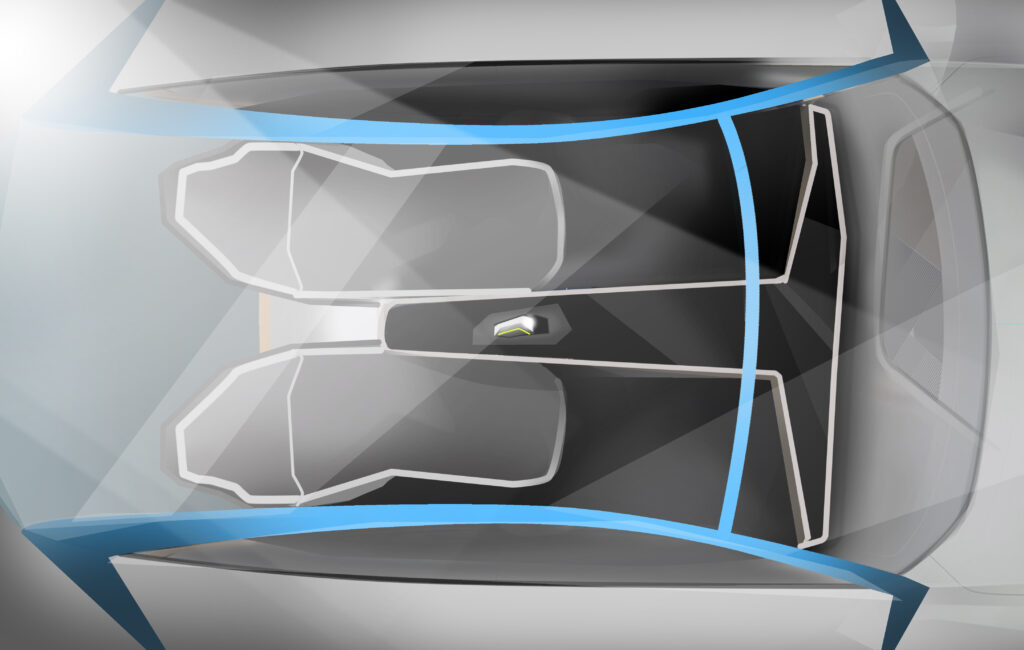What does mobility of the future look like? Researchers from six Fraunhofer Institutes have developed a groundbreaking vehicle concept that can be flexibly and individually designed depending on the intended use.
 The concept calls for a modular passenger cell, following the logic of a shell principle, that can be flexibly adapted to the individual needs of the travelers: during the day, it serves as a communicative lounge; at night, it becomes a peaceful capsule for rest and recovery on long-haul trips. The interior can be adjusted flexibly and adapted in terms of settings. The materials used are made from renewable sources or are designed to optimize their ability to be reused or recycled. The entire module can be coupled with various mobility bases – with a vehicle platform, an air taxi, or a Hyperloop solution, depending on the need. It can also be transformed into an interactive virtual-reality lounge that enables limitless virtual travel around the whole world, thus contributing to an innovative component of new mobility and building designs. “The foundation of our mobility concept is the autonomous, light, and personalized AllCell, which is compatible with various platforms. The AllCell can drive or fly, always under the power of the most efficient fuel,” explains Dr. Torben Seemann, who – in his role as the head of Smart Matrix Production at Fraunhofer IST, one of the member institutes at the Fraunhofer project center in Wolfsburg – is playing a critical role in the development of the mobility concept. “Our concept is the luxury edition of individual travel. The exterior, interior, and information and communication technology are modular, customizable, and adaptive to the context. The interior of the AllCell can be easily modernized and is always on the cutting edge in terms of technology,” says Sebastian Stegmüller, head of the Mobility Innovation department at Fraunhofer IAO. Another special feature of the concept is the sustainable vehicle structure, which is divided into long-lasting reusable components and nondurable wear components, as well as design-relevant components. “The durable components are recycled after their end of life and reused in new vehicles. The nondurable parts are designed to achieve material recycling levels of nearly 100 percent,” explains Dr. Philipp Rosenberg, head of the lightweight structures group at Fraunhofer ICT. The innovative mobility concept was one of five recommendations taken by Fraunhofer to the #NEXTGen Moving Tomorrow Pitch, an idea competition organized by car manufacturer BMW. The competition is aimed at finding a “visionary, sustainable, and holistic complete concept for mobility in 2040.” Around the world, BMW had called on researchers from a total of ten renowned research institutes to submit recommendations that would improve the lives of future generations, are designed for the users, make cities smarter, or are meant to enable entirely new technologies. Fraunhofer was the only nonuniversity research institute that took part in the idea competition. Along with two teams from the elite Chinese Tsinghua University, the Vision PI team from Fraunhofer made it into the top three with its idea of an individual passenger cell.
The concept calls for a modular passenger cell, following the logic of a shell principle, that can be flexibly adapted to the individual needs of the travelers: during the day, it serves as a communicative lounge; at night, it becomes a peaceful capsule for rest and recovery on long-haul trips. The interior can be adjusted flexibly and adapted in terms of settings. The materials used are made from renewable sources or are designed to optimize their ability to be reused or recycled. The entire module can be coupled with various mobility bases – with a vehicle platform, an air taxi, or a Hyperloop solution, depending on the need. It can also be transformed into an interactive virtual-reality lounge that enables limitless virtual travel around the whole world, thus contributing to an innovative component of new mobility and building designs. “The foundation of our mobility concept is the autonomous, light, and personalized AllCell, which is compatible with various platforms. The AllCell can drive or fly, always under the power of the most efficient fuel,” explains Dr. Torben Seemann, who – in his role as the head of Smart Matrix Production at Fraunhofer IST, one of the member institutes at the Fraunhofer project center in Wolfsburg – is playing a critical role in the development of the mobility concept. “Our concept is the luxury edition of individual travel. The exterior, interior, and information and communication technology are modular, customizable, and adaptive to the context. The interior of the AllCell can be easily modernized and is always on the cutting edge in terms of technology,” says Sebastian Stegmüller, head of the Mobility Innovation department at Fraunhofer IAO. Another special feature of the concept is the sustainable vehicle structure, which is divided into long-lasting reusable components and nondurable wear components, as well as design-relevant components. “The durable components are recycled after their end of life and reused in new vehicles. The nondurable parts are designed to achieve material recycling levels of nearly 100 percent,” explains Dr. Philipp Rosenberg, head of the lightweight structures group at Fraunhofer ICT. The innovative mobility concept was one of five recommendations taken by Fraunhofer to the #NEXTGen Moving Tomorrow Pitch, an idea competition organized by car manufacturer BMW. The competition is aimed at finding a “visionary, sustainable, and holistic complete concept for mobility in 2040.” Around the world, BMW had called on researchers from a total of ten renowned research institutes to submit recommendations that would improve the lives of future generations, are designed for the users, make cities smarter, or are meant to enable entirely new technologies. Fraunhofer was the only nonuniversity research institute that took part in the idea competition. Along with two teams from the elite Chinese Tsinghua University, the Vision PI team from Fraunhofer made it into the top three with its idea of an individual passenger cell.



